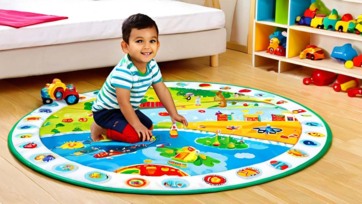Behind the stories about nursery rhymes songs

The Story Behind Row, Row, Row Your Boat
The Story Behind "Row, Row, Row Your Boat"
"Row, Row, Row Your Boat" is one of the most popular and widely recognized nursery rhymes in the world. Its simple melody and repetitive lyrics make it a favorite among young children, while its gentle, flowing rhythm mimics the peaceful act of rowing down a river. Though often seen as a fun and playful song, "Row, Row, Row Your Boat" also carries a deeper message about life and the importance of going with the flow.
Origins and History
The exact origins of "Row, Row, Row Your Boat" are unclear, but the song is believed to have first appeared in the United States during the mid-19th century. The earliest known printed version of the song dates back to 1852, making it one of the older nursery rhymes still sung today.
The rhyme was initially part of the folk tradition, passed down orally through generations. Over time, it became a staple in children's music, and its universal appeal helped it spread across different cultures. Today, it remains one of the most recognizable and widely taught songs in early childhood education.
Educational Value
One of the key reasons "Row, Row, Row Your Boat" is so beloved in early education is its simplicity. The repetitive lyrics and easy-to-remember tune make it an excellent song for young children to learn and sing along to. Singing the song helps develop important skills such as language acquisition, memorization, and rhythm.
Additionally, the song can be used to introduce children to the concept of cooperation and teamwork. Often sung as a round, "Row, Row, Row Your Boat" encourages children to listen to others and harmonize their voices, promoting social skills and collaboration. The act of singing in a round also teaches children about timing and coordination, as each group must start their verse at the right moment.
The lyrics also provide an opportunity for discussions about nature and movement. Teachers and parents can use the song to explain concepts such as water, boats, and the physical act of rowing. Some versions of the song even include hand motions that mimic rowing, adding an extra layer of physical engagement for children.
Philosophical Interpretations
Although "Row, Row, Row Your Boat" is primarily viewed as a playful children's song, many have pointed out the philosophical undertones present in its lyrics. The line "Life is but a dream" suggests a perspective on life that encourages a carefree and peaceful approach, reminding us to go with the flow and enjoy the journey rather than focusing solely on the destination.
The metaphor of rowing gently down the stream can also be seen as a representation of how we navigate through life. The gentle rowing suggests a calm and steady pace, promoting mindfulness and the importance of not rushing through life. In this sense, "Row, Row, Row Your Boat" carries a deeper message that resonates with both children and adults alike.
Cultural Impact
"Row, Row, Row Your Boat" has had a significant cultural impact, appearing in various forms of media, including films, television shows, and books. The song’s timeless message and playful melody have made it a staple in early childhood education, and it continues to be a favorite for children and parents around the world.
The song is often used in group settings such as preschools and playgroups, where children sing it together while performing the rowing motions. This physical interaction with the song helps reinforce the lyrics and makes it more engaging for young learners.
Conclusion
"Row, Row, Row Your Boat" is more than just a simple nursery rhyme; it is a song that combines fun, education, and deeper philosophical themes. Its enduring popularity is a testament to its universal appeal, and its ability to engage young children while also offering a valuable lesson about life. Whether used in a classroom, at home, or as a lullaby, this timeless classic will continue to be a beloved part of children's lives for generations to come.